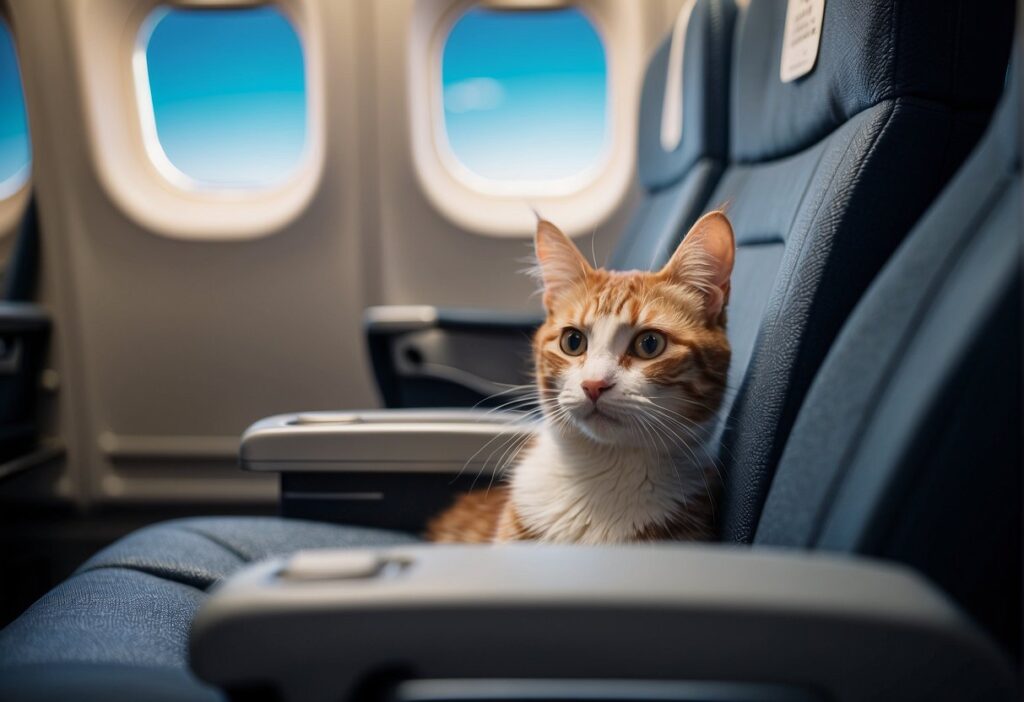Traveling internationally with an emotional support animal (ESA) has become more complex due to changes in airline policies over recent years. It’s important to understand these changes to ensure a smooth travel experience for both you and your animal companion. Since January 2021, the regulations governing ESAs on planes have tightened, and many airlines have adjusted their policies, no longer automatically accepting ESAs as service animals. This means that you can’t simply arrive at the airport with your ESA and expect to board without prior preparation.
As you plan your journey, you’ll need to navigate a variety of requirements and restrictions that can vary by airline and destination. It’s important to start the process early, as obtaining the necessary paperwork and clearances for your ESA can take several weeks, or even months. Airlines typically require advance notice if you are traveling with an ESA, and there may be additional costs involved if your pet needs to fly as checked luggage.
Traveling Internationally with Emotional Support Animals
Bringing your emotional support animal (ESA) with you on an international flight requires navigating various regulations. You’ll need to consider country-specific rules, quarantine procedures, and the cultural attitude towards animals in your destination.
Country-Specific Regulations and Restrictions
Each country has its own set of regulations regarding the importation and transport of animals. For example:
- Australia requires an import permit for all animals, which includes ESAs.
- New Zealand has strict biosecurity laws, necessitating that your ESA meet specific health standards and possibly undergo quarantine.
- Hong Kong might have different entry requirements than Australia and New Zealand, including documentation proving your pet’s rabies vaccination.
Always check with the embassy or animal quarantine service of your destination country well in advance.
Cultural Attitudes and Accessibility
The cultural reception and accessibility for ESAs differ significantly around the world:
- In some parts of the world, ESAs are welcomed in public spaces, while in others, they might face stringent restrictions.
- Always research the cultural attitudes of your destination to avoid any inconveniences.
By checking your destination’s regulations, and understanding cultural nuances, your trip with your ESA can be smooth and stress-free.
Legal Framework and Airline Policies
Before you book a flight with your emotional support animal (ESA), first understand the legal requirements and the varied policies of different airlines.
Department of Transportation (DOT) Guidelines
The DOT clearly defines that airlines can recognize ESAs as pets rather than service animals. According to their guidelines, only dogs can be considered as service animals, which must be trained to help individuals with disabilities. Nothing is said about ESAs.
Air Carrier Access Act Compliance
Under the Air Carrier Access Act (ACAA), your rights in traveling with an ESA have changed recently. Airlines can now treat ESAs as pets, and this has led to additional fees and restrictions compared to the previous accommodations for ESAs.
Airlines’ Individual Policies
While policies vary, most airlines require you to submit an ESA letter from a licensed mental health professional.
- Alaska Airlines: Size restrictions apply, and your animal should fit within your personal space.
- American Airlines: ESAs are welcomed as pets, which implies following the standard pet travel requirements.
- Delta Air Lines and United Airlines have also adapted their policies, generally requiring documentation to be submitted well before your flight.
Recent Changes and Notices
Keep an eye out for policy changes and notices of proposed rule-making that could affect your travel plans with ESAs. For example, Alaska was among the first to update its policy in 2021. Policy shifts tend to reflect a more restrictive stance on ESAs, commonly requiring advance notice and proper documentation.
Choosing the Right Airline and Flight

Comparing Airline Pet Policies
Different airlines have specific rules for traveling with ESAs. United, Delta, and American Airlines have tightened their regulations, often requiring additional documentation and limiting the types of animals that can fly. For instance, American Airlines now only accepts cats and dogs, and they must be kept in a carrier. Alaska Airlines was one of the first to update its policy, which includes a ban on emotional support animals that aren’t service dogs. On the other hand, JetBlue, Southwest, and Hawaiian Airlines offer more lenient policies but still have restrictions to adhere to for international flights. Always check the most up-to-date policies on the airline’s official website.
Direct Flights Versus Layovers
Opting for direct flights can reduce stress for your ESA by minimizing travel time and avoiding the hassle of transferring flights. Delta and United often provide a number of direct international routes, which can be a smoother option compared to flights with layovers. However, airlines like Frontier may not provide as many direct international options, potentially leading to longer journey times and additional layovers.
Assessing Fees and Additional Costs
Costs can vary greatly between airlines when flying with ESAs. American, United, and Delta may charge a pet fee for international travel, even if your animal qualifies as an ESA. Some airlines, such as JetBlue and Southwest, may have lower fees, but it’s important to factor in all potential costs, including health certificates and any additional charges that may apply for international travel. Prices can fluctuate, so it’s best to get a current quote from the airline when booking your flight.
Preparing Your Emotional Support Animal for Flight
Ensuring your emotional support animal is ready for international travel requires attention to health and safety guidelines, adherence to training standards, and proper documentation.
Health and Safety Requirements
Your emotional support animal’s health is paramount. Prior to your flight, you should have all vaccinations up to date, including rabies and distemper. It’s essential to carry vaccination records with you as proof of your animal’s health status. Ensure your pet is fit to fly and consider a health check with your vet before you travel.
Behavior and Training Standards
A well-behaved emotional support animal is essential for a smooth trip. Your animal should be trained, harnessed, leashed, or tethered at all times during the flight. This ensures not only their safety but also the comfort of other passengers. It’s important that they can handle the stress of travel without disruptive behavior.
Documentation and Certification
Airlines often require specific documentation and certification for emotional support animals. While federal guidelines have evolved, it’s critical to check the airline’s policy and the regulations of your destination country. Have all necessary documents on hand, including any required ESA letter or certificate from a licensed healthcare professional.
On the Day of the Flight
When you’re heading to the airport with your emotional support animal (ESA), it’s important to be prepared for the check-in and boarding process, ensure your animal’s comfort and safety during the flight, and be ready to handle any potential incidents or allergens.
Check-In Process and Boarding
Check-in: Ensure you arrive early as you’ll need extra time to check in with your ESA. The breed and size of your animal may require additional accommodations.
Documentation: Have your ESA’s documentation handy. Airlines may have specific requirements for these documents.
Kennel: If your ESA is too large to fit under the seat, they may need to travel in a kennel in the cargo hold or adjust to fit in an approved size within the cabin.
Tips: Familiarize yourself with the airline’s policies before you arrive at the airport to speed up the process.
Boarding:
- Seating: Secure a space for your ESA, especially if they cannot fit under the seat in front of you. Exit row seating isn’t allowed for passengers with ESAs for safety reasons.
- Process: Be aware that boarding procedures may take longer as you and your ESA may need to be accommodated.
During the Flight: Ensuring Comfort and Safety
- Safety: Keep your ESA’s harness or leash on throughout the flight to ensure their safety and the safety of fellow passengers.
- Comfort: A familiar blanket or toy can help keep your ESA calm and comfortable during the flight.
Dealing with Potential Incidents and Allergies
- Incidents: Should your ESA become distressed or disruptive, remain calm and follow any instructions given by the flight crew.
- Allergies: Be mindful of other passengers who may have allergies. Notify the airline in advance so they can make necessary arrangements.
Post-Flight Procedures and Considerations
After your international flight with your emotional support animal, it’s important to prioritize their welfare, document the journey, and consider future travel plans. Here’s what you need to know to make post-flight as smooth as possible.
Animal Welfare after Landing
Once you’ve landed, your first task should be to ensure your animal’s welfare. This involves checking their health and comfort after the flight. If necessary, seek out airport pet relief areas so they can stretch and relieve themselves. Here’s a quick checklist for you to follow:
- Hydration: Offer water to rehydrate.
- Feeding: Give them a meal at their usual feeding schedule.
- Exercise: Locate a pet area for some exercise.
- Health Check: Monitor for any signs of stress or illness.
Reporting and Documenting Travel Experiences
It’s wise to document your experience when traveling with your emotional support animal, especially if issues arise. Put together a report that includes:
- Flight details: Date, flight number, and airline.
- Incidents: If something went wrong, describe it.
- Animal behavior: Note how your animal coped with the travel.
Send this report to the airline’s customer service via email with your contact information. Make sure you get a signature from any airline official who assisted you, as this can serve as proof of the conversation.
Future Travel Planning
Think about how the flight went and what could be improved for next time. Consider these points:
- Health documentation: Keep all health and vaccination records up-to-date.
- Airline feedback: Note any responses from your report for future reference.
- Travel necessities: List items that were helpful or anything else needed.
By considering these factors, you’ll be better equipped for future trips with your emotional support animal. Keep all documentation in an easily accessible place for quick reference when planning your next flight.
To manage the logistics of flying with your ESA, you’ll have to familiarize yourself with both the airline’s specific policies and the regulations of the country you’re traveling to. This ensures that when you arrive at the airport, you’ve taken all the necessary steps to make your trip with your emotional support animal as seamless as possible. Keep in mind the importance of also adhering to general pet travel etiquette and safety measures for the benefit of all passengers and crew onboard.











